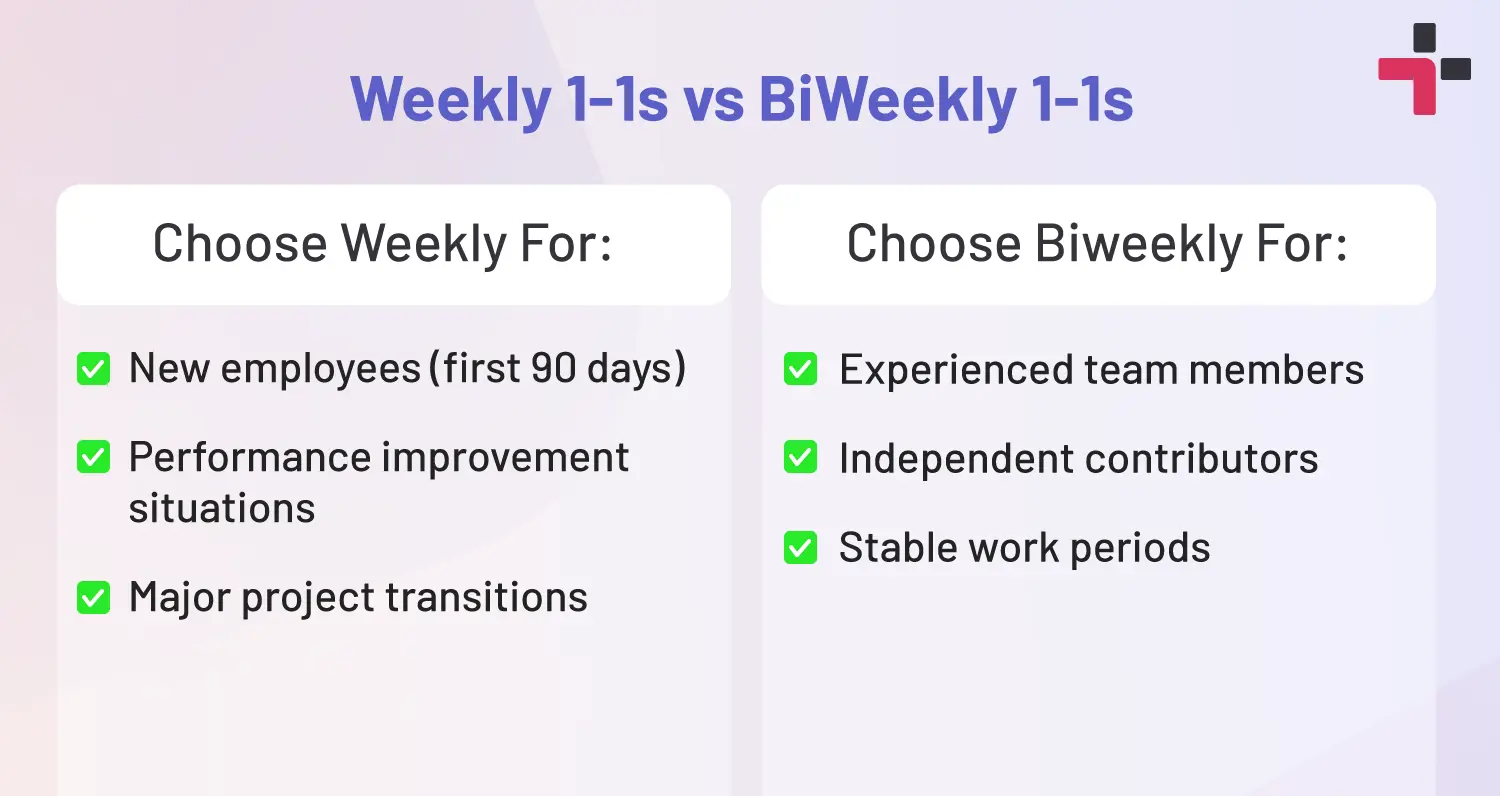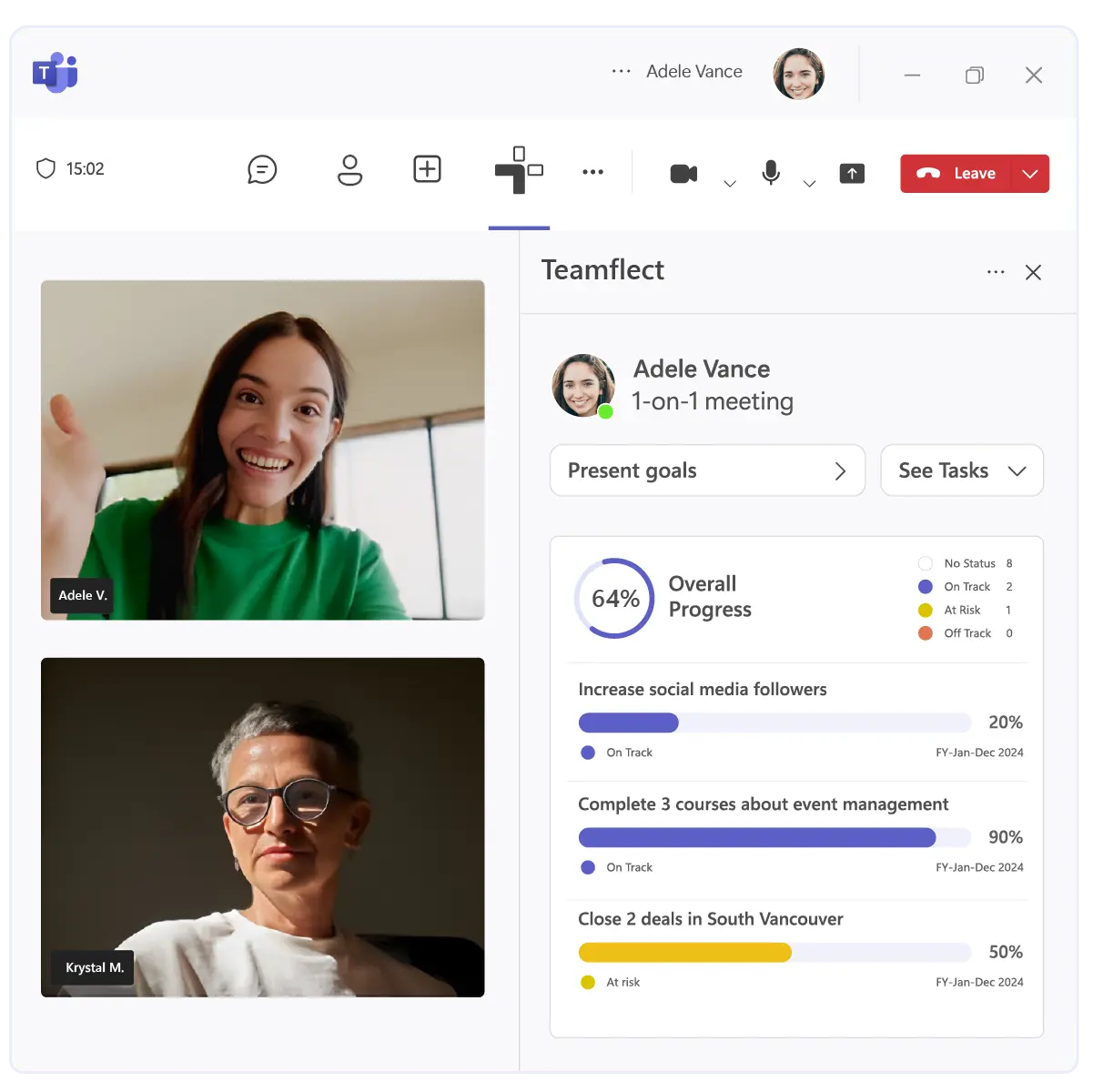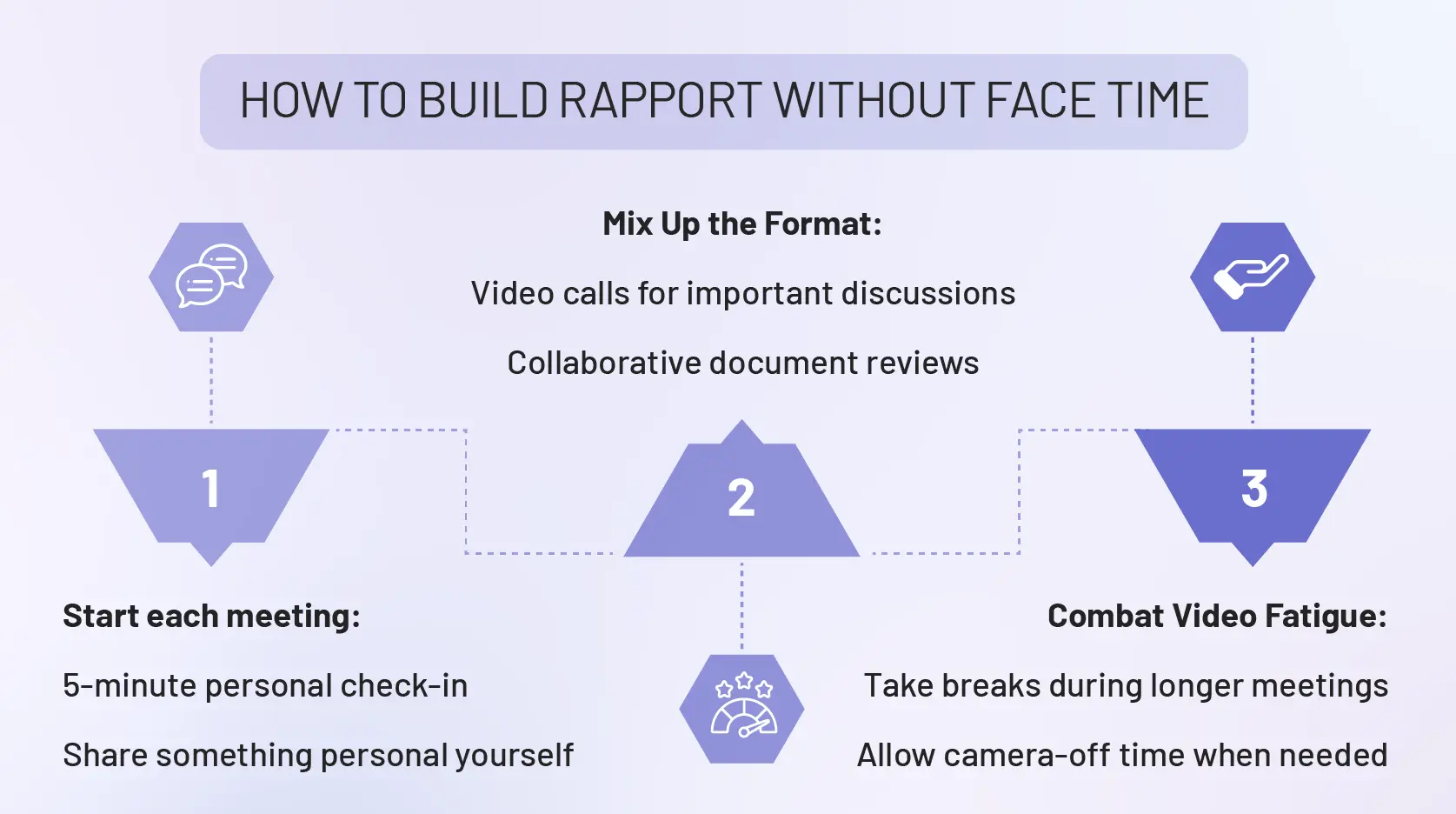|
The shift to remote and hybrid work has made these individual touchpoints even more critical. Without casual hallway conversations, structured one-on-ones have become your primary opportunity to build trust, provide support, and drive employee growth. One-on-one meetings are the most powerful tool for building strong manager-employee relationships. When done right, they boost engagement by 300% and increase team productivity by 18%(Source: Gallup). This guide shows you exactly how to run effective one-on-one meetings that your team members will actually value, focusing on development over surveillance, outcomes over activity, and relationship-building over reporting.
TL;DR — Quick Summary Impact Stats: Regular 1-on-1s boost engagement by 300%, increase productivity by 18%, and reduce turnover by 67% when held weekly. Optimal Frequency: Weekly for new employees and challenging periods, bi-weekly for experienced team members—consistency matters more than frequency. Duration Guidelines: 30 minutes for routine check-ins, 45 minutes for development discussions, 60 minutes for career planning and complex challenges. Employee-Led Approach: Let employees drive 70% of the conversation and set the agenda—focus on their development, not status updates. 5-Part Agenda: Personal check-in (5 min), current priorities/challenges (15 min), development goals (15 min), two-way feedback (10 min), action items (5 min). Remote Adaptations: Use video for important discussions, start with personal check-ins, vary formats (walking calls, phone-only), combat video fatigue. Focus on open-ended questions, document commitments, create psychological safety, and address issues early rather than waiting for performance reviews. Avoid status updates, never cancel (reschedule instead), don't confuse with performance reviews, and maintain presence by eliminating distractions. Why One-on-One Meetings Matter More Than EverThe shift to remote and hybrid work has made intentional communication more critical than ever. Without casual hallway conversations and impromptu desk visits, structured one-on-one meetings have become the primary vehicle for building meaningful manager-employee relationships. Engagement Statistics Every Manager Should KnowAnother Gallup Study across some leading organizations consistently shows that regular one-on-one meetings dramatically improve workplace outcomes. These key statistics from the study that we are choosing to highlight here show just how important regular and effective 1-1 meetings can be in driving productivity and boosting engagement. Key Stats: Employees with regular 1-on-1s are 3x more engaged Teams with engaged employees show 23% higher profitability Employees are 67% less likely to be disengaged when managers hold regular 1-on-1s One-on-Ones vs. Team Meetings: What's the Difference?Many managers confuse one-on-one meetings with scaled-down team meetings, but they serve completely different purposes. Understanding this distinction is crucial for making your individual meetings effective. Team Meetings: One-on-One Meetings:
📚 Recommended Reading: What about all-hands meetings? Complete Guide to All-Hands Meetings How Often and How Long Should 1-on-1s Be?
Finding the right meeting cadence and duration for your one-on-one meetings depends on several factors, including your team member's experience level, current challenges, and work environment. The key is establishing a rhythm that works for both parties and sticking to it consistently. What is the right one-on-one meeting frequency?The frequency of your meetings should match your team member's current needs and situation. Consider their experience level, the complexity of their role, and any ongoing challenges they're facing. Choose Weekly For: New employees (first 90 days) Performance improvement situations Major project transitions Remote team members Choose Biweekly For: Experienced team members Independent contributors Stable work periods How long should one-on-one meetings be?The length of your one-on-one meetings should allow for meaningful conversation without becoming a burden on either person's schedule. Most effective meetings fall within a specific range that balances depth with efficiency. Rule: Better to have consistent 30-minute meetings than sporadic 60-minute ones. The Perfect One-on-One Meeting Agenda Template
To help you run the most effective one-on-one meetings with your direct reports or members of your team, we created a wide variety of meeting agenda templates you can download for free.
Download 10 Tips to Make Your One-on-Ones More EffectiveThese strategies transform ordinary check-ins into powerful development conversations. Each tip addresses a specific challenge that managers commonly face in their one-on-one meetings. 1. Let the Employee Drive the ConversationThe most effective one-on-one meetings are employee-led, not manager-driven. When you let your team member set the agenda and lead the discussion, they're more likely to bring up what's truly important to them. Employee talks 70% of the time Manager facilitates and asks questions Employee sets priorities and topics
📚 Recommended Reading: What Are Skip-Level Meetings? Complete Guide with Best Practices Skip-Level Meeting Guide 2. Use Open-Ended QuestionsThe quality of your questions determines the depth of your conversations. Open-ended questions encourage reflection and reveal insights that yes/no questions simply can't uncover. Instead of: "How's the project?" Ask: "What's exciting you about this project, and what's keeping you up at night?" Better Questions: "What would make your job easier?" "What's one thing you'd change about our team?" "Where do you want to grow next?" 3. Document Next Steps Every TimeWithout clear action items and follow-through, even the best conversations lose their impact. Documentation creates accountability and shows that you take these meetings seriously. Write down commitments during the meeting Review previous commitments at start of next meeting Use shared document for accountability 4. Using One-on-One Meeting Software
Using one-on-one meeting software can streamline your process and provide valuable insights over time. While not essential, the right tool can help you maintain consistency and track progress more effectively. While there are some great meeting tools out there, the best software for one-on-one or team meetings for organizations in the Microsoft 365 ecosystem is Teamflect. Teamflect is a one-on-one meeting software built specifically for Microsoft Teams, that integrates not only with your Microsoft Teams account but also your entire Outlook calendar, syncing your meetings and agendas automatically. It also let's you create comprehensive meeting agendas with recurring talking points, minutes, check-in forms, and so much more. As a complete performance management platform, Teamflect also integrates other key features into your meetings such as goal progress, employee recognition, feedback templates, and more. Key Benefits:
Schedule a demo 5. Create Psychological SafetyPeople only share what's really on their minds when they feel safe to do so. Creating psychological safety requires vulnerability from you as the manager and consistent positive responses to difficult conversations. Share your own challenges first Ask for feedback on your leadership Respond positively to difficult conversations Never punish honesty 6. Focus on Development, Not Just PerformanceWhile performance matters, one-on-one meetings should primarily focus on growth and future possibilities. This forward-looking approach energizes employees and demonstrates your investment in their success. Development Questions: "What skills do you want to build?" "What experiences are you seeking?" "How can I help you reach your goals?" 7. Listen More Than You TalkActive listening is perhaps the most important skill for effective one-on-one meetings. Your job is to understand, not to be understood. This requires discipline and genuine curiosity about your team member's perspective. The 70/30 Rule: Employee speaks: 70% Manager speaks: 30% Focus on active listening Ask clarifying questions 8. Address Issues EarlySmall problems become big problems when left unaddressed. One-on-one meetings provide the perfect opportunity to give timely feedback and course-correct before issues escalate. Don't wait for performance reviews Give feedback within 24-48 hours Focus on specific behaviors Offer support and solutions 9. Celebrate Wins TogetherRecognition in one-on-one meetings feels more personal and meaningful than public praise. Taking time to acknowledge achievements, both big and small, reinforces positive behaviors and builds motivation. 10. Be Present and EngagedYour presence, or lack thereof, sends a powerful message about the value you place on the relationship. Being fully present requires intentional choices about how you show up to these conversations. How to Show Presence: Phone on silent or away Close laptop unless taking notes Make eye contact (video calls) Give full attention for entire meeting Remote One-on-Ones: What's Different and What Isn't
Remote work has changed the mechanics of one-on-one meetings, but the core principles remain the same. The challenge lies in adapting relationship-building techniques that were designed for in-person interactions to virtual environments. How to Build Rapport Without Face Time?Building personal connections through a screen requires more intentionality than in-person interactions. You need to work harder to create moments of human connection and combat the natural barriers that technology creates. Start Each Meeting: 5-minute personal check-in Ask about home office setup Discuss interests outside work Share something personal yourself Mix Up the Format: Video calls for important discussions Phone calls for casual check-ins Walking meetings for brainstorming Collaborative document reviews Combat Video Fatigue: Offer phone-only options Take breaks during longer meetings Use screen sharing sparingly Allow camera-off time when needed What to Say in a One-on-One Meeting (Sample Prompts)Having the right questions ready can transform an awkward silence into a meaningful conversation. These conversation starters have been tested in thousands of one-on-one meetings and consistently generate valuable discussions. For Managers: Supportive, Clear, and CuriousYour role as a manager is to create space for your team member to share what's really on their mind. These questions are designed to open doors and invite deeper conversation. Opening Questions: "What's going well for you this week?" "What's been challenging lately?" "How are you feeling about your workload?" Development Questions: "What would you like to learn next?" "What projects excite you most?" "How can I better support your growth?" Support Questions: "What obstacles can I help remove?" "What decisions are you waiting on?" "What resources do you need?" Feedback Questions: "What should I do differently as your manager?" "How do you prefer to receive feedback?" "What's working well in our communication?" For Employees: Speak Up About Growth and BlocksAs an employee, one-on-one meetings are your opportunity to get the support, resources, and development you need. Come prepared with specific topics and be ready to drive the conversation toward what matters most to you. Come Prepared to Discuss: Your Development: Skills you're building Learning opportunities you want Career goals and interests Feedback on current projects Your Challenges: Specific obstacles you're facing Resources or support needed Decisions you're waiting on Process improvements Your Feedback: What's working well What could be improved Communication preferences Team collaboration ideas What Not to Do in a One-on-One MeetingEven well-intentioned managers can fall into traps that undermine the effectiveness of their one-on-one meetings. Avoiding these common mistakes will dramatically improve the quality of your conversations. Avoid Status UpdatesIf your one-on-one feels like a verbal project management report, you're missing the opportunity for deeper connection and development. Status updates should happen through other channels, freeing up your precious one-on-one time for more meaningful conversations. Don't Ask: "What did you work on this week?" "How's Project X coming along?" "What's your progress on the deliverables?" Instead Ask: "What's challenging you this week?" "Where do you need support?" "What's energizing you about your work?" Don't Cancel—Reschedule InsteadCanceling one-on-one meetings sends a clear message about priorities, and it's rarely the message you intend to send. When urgent matters arise, your response shows how much you value the relationship. When You Must Reschedule: Give 24+ hours notice when possible Explain the reason briefly Offer 2-3 alternative times immediately Apologize for the inconvenience Example Message: "I need to reschedule our 1-on-1 due to a client emergency. Are you available tomorrow at 2 PM or Thursday at 10 AM instead?" Don't Let It Become a Performance ReviewOne-on-one meetings and performance reviews serve different purposes and should feel different to your team member. Confusing the two can create anxiety and reduce the psychological safety that makes one-on-ones effective. Performance Reviews Are: Formal evaluation processes Documentation-heavy Focused on ratings and rankings Scheduled quarterly or annually One-on-Ones Are: Ongoing development conversations Relationship-building focused Support and growth oriented Regular and informal FAQs About One-on-One MeetingsThese frequently asked questions address the most common concerns and misconceptions about one-on-one meetings. Understanding these fundamentals will help you implement more effective practices. What is a one-on-one meeting?A one-on-one meeting is fundamentally different from other workplace conversations. It's a dedicated time for building the manager-employee relationship and supporting individual growth. A one-on-one meeting is a private, recurring conversation between a manager and employee focused on: Professional development Relationship building Providing support and removing obstacles Career growth discussions Duration: 30-60 minutes Frequency: Weekly or biweekly Focus: Employee-driven development conversations How often should managers have one-on-one meetings?The frequency of your one-on-one meetings should match your team member's current needs and situation. Different circumstances call for different approaches, but consistency is more important than frequency. Weekly: New employees, performance improvement, major transitions Biweekly: Experienced team members, stable periods Monthly: Senior individual contributors (minimum frequency) Best Practice: Consistency matters more than frequency. Choose a schedule you can maintain long-term. What should be discussed in a 1-on-1 meeting?The topics you discuss in one-on-one meetings should focus on your team member's growth, challenges, and success. This isn't the time for routine project updates or information that could be shared more efficiently through other channels. Always Discuss: Current challenges and obstacles Professional development goals Career aspirations and interests Two-way feedback Support and resource needs Never Discuss: Detailed project status updates Information better shared via email Other team members' performance issues Formal performance evaluations How long should a one-on-one meeting last?The duration of your one-on-one meetings should allow for meaningful conversation without overwhelming either person's schedule. Most effective meetings fall within a specific range that balances depth with practical constraints. 30 Minutes: Standard check-ins, quick problem-solving 45 Minutes: Development discussions, feedback sessions 60 Minutes: Career planning, complex challenges Tip: Start with 30 minutes and extend as needed. Quality conversation matters more than duration. What's the best one-on-one meeting agenda?The best agenda provides structure while remaining flexible enough to address what matters most to your team member. This simple framework ensures you cover essential areas while maintaining a natural conversation flow. Simple 5-Part Agenda: Check-in (5 min): How are you doing? Progress (15 min): Current priorities and challenges Development (15 min): Growth and learning goals Feedback (10 min): Two-way feedback exchange Next Steps (5 min): Commitments and action items Pro Tip: Use a shared document so both parties can add topics beforehand. How do I run effective one-on-ones remotely?Remote one-on-one meetings require more intentional relationship building than in-person conversations. You need to work harder to create personal connection and combat the natural barriers that technology creates. Key Strategies: Use video for important conversations Start with personal check-ins (5+ minutes) Vary the format (walking calls, phone-only) Be more intentional about relationship building Combat video fatigue with breaks Same Principles Apply: Employee-driven conversations Focus on development over status Document next steps Maintain consistency Should one-on-one meetings be private or shared with HR?Understanding what to keep private and what to document is crucial for maintaining trust while meeting your organizational responsibilities. The key is being transparent with your team member about what gets shared and why. Keep Private: Individual conversations and feedback Personal development discussions Career aspirations and concerns Relationship-building moments Document and Share: Development commitments and goals Resource requests and decisions Performance improvement plans Serious conduct or policy issues Best Practice: Be transparent with employees about what gets documented and shared. Quick Start Guide: Your First Effective 1-on-1Getting started with effective one-on-one meetings doesn't have to be complicated. This quick start guide provides everything you need to run your first successful meeting and establish a strong foundation for ongoing conversations. Before the Meeting: Send calendar invite with shared agenda doc Add 2-3 questions to get conversation started Block time in quiet, private space During the Meeting: Start with genuine personal check-in Let employee drive 70% of conversation Ask open-ended questions Take notes on commitments End with clear next steps After the Meeting: Send recap of commitments within 24 hours Follow through on your promises Add next meeting topics to shared agenda Schedule consistently for long-term success Remember: Great 1-on-1s are built through consistency, genuine care, and focusing on your employee's growth and success. Written by Emre Ok Emre Ok is a Certified Human Resources Professional and Senior Content Manager at Teamflect, where he writes extensively on Performance Management, Employee Engagement, HR Technology, and the future of work inside Microsoft ecosystems. He is also the host of The Team Check-In podcast, where he regularly interviews top thought leaders in human resources, leadership, and Microsoft-powered workplace tools. Emre’s work is guided by a simple principle: Help creating heavily researched and data-backed content that helps HR teams work smarter, not harder and leverage the right technology. (责任编辑:) |




